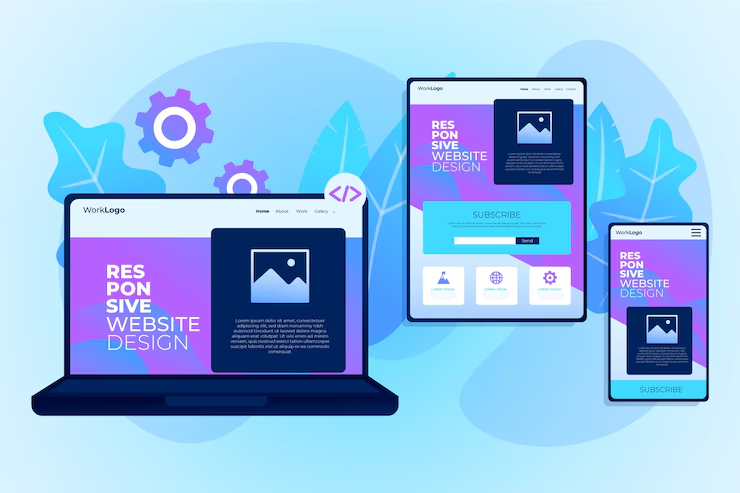In today’s fast-paced digital landscape, where user experience can make or break a web application, responsive design has emerged as a pivotal aspect of web application development. As users access applications on a myriad of devices—ranging from desktops and laptops to tablets and smartphones—ensuring that your web application is visually appealing and functionally robust across all these platforms is crucial. This blog delves into the importance of responsive design, its impact on web application success, and how it ties into web application development services and android app development.
Understanding Responsive Design
Responsive design refers to an approach that ensures a web application adapts seamlessly to various screen sizes and orientations. It involves fluid grids, flexible images, and CSS media queries, allowing content to adjust dynamically based on the device being used. The primary goal of responsive design is to provide users with a consistent and optimal viewing experience, minimizing the need for resizing, panning, or scrolling.
The Key Elements of Responsive Design
- Fluid Grids: Instead of fixed pixel-based layouts, responsive design employs percentages for layout dimensions, allowing elements to resize proportionally to the screen size.
- Flexible Images: Images are set to a maximum width of 100% in CSS, ensuring they resize and do not exceed their containing elements.
- Media Queries: These are CSS techniques that apply styles based on the device characteristics, such as width, height, resolution, and orientation. This ensures that the layout can change according to the specific device being used.
The Importance of Responsive Design
1. Enhanced User Experience
User experience is paramount in determining the success of any web application. Responsive design ensures that users have a smooth and enjoyable experience, regardless of the device they are using. When a website is responsive:
- Consistency Across Devices: Users can navigate and interact with the application seamlessly on any device. Whether on a mobile phone, tablet, or desktop, users expect the same functionalities and layout.
- Improved Loading Speed: Responsive design can optimize images and reduce unnecessary elements, leading to faster loading times. Slow-loading applications can frustrate users, leading them to abandon the site.
- Accessibility: Responsive design enhances accessibility, making it easier for users with disabilities to interact with the application. This is crucial as it aligns with the goal of providing an inclusive digital environment.
2. Increased Mobile Traffic
According to recent statistics, mobile devices account for over half of all web traffic globally. This trend highlights the necessity for web applications to cater to mobile users. Responsive design plays a vital role here by:
- Accommodating Mobile Users: A responsive web application provides an optimal experience for mobile users, leading to increased engagement and reduced bounce rates.
- SEO Benefits: Search engines like Google prioritize mobile-friendly websites in their rankings. By utilizing responsive design, businesses can improve their search engine visibility, ultimately driving more traffic to their web applications.
3. Cost Efficiency
Investing in responsive design can lead to significant cost savings in the long run:
- Single URL for All Devices: A responsive web application uses a single URL for all devices, simplifying the management and maintenance process. This reduces the complexity of having multiple versions of a site for different devices.
- Lower Development Costs: Instead of developing separate applications for various devices (such as an Android app), businesses can focus on a single responsive application. This can lead to reduced development costs and resource allocation.
4. Future-Proofing
Technology evolves rapidly, and new devices emerge regularly. Responsive design helps businesses stay ahead of the curve:
- Adaptability: Responsive applications can easily adapt to new devices and screen sizes, ensuring longevity and relevance in a fast-changing tech landscape.
- Improved Performance: A well-designed responsive application can enhance performance across various devices and screen resolutions, contributing to the overall success of the application.
How Responsive Design Influences Web Application Development Services
1. Focus on User-Centric Development
Web application development services are increasingly prioritizing user-centric approaches. Responsive design directly aligns with this focus:
- User Research: Developers engage in user research to understand how different users interact with the application on various devices. This informs design decisions and ensures a positive user experience.
- Usability Testing: Responsive applications undergo rigorous usability testing to identify and address potential issues, enhancing the overall user experience.
2. Collaboration Between Design and Development Teams
Responsive design fosters collaboration between design and development teams, leading to a more cohesive application:
- Integrated Workflows: Designers and developers work together to ensure that the application is visually appealing and functionally robust across devices. This integration can lead to faster development cycles and improved outcomes.
- Continuous Improvement: Responsive design encourages iterative development, allowing teams to make ongoing improvements based on user feedback and testing.
3. Leveraging Modern Technologies
The rise of responsive design has led to the adoption of modern technologies and frameworks in web application development:
- Frameworks and Libraries: Tools like Bootstrap and Foundation facilitate responsive design by providing pre-built components and grids, streamlining the development process.
- Progressive Enhancement: This approach focuses on providing a baseline experience for all users while enhancing it for those with better capabilities. This ensures that the application is accessible to a broader audience.
The Role of Responsive Design in Android App Development
1. Cross-Platform Compatibility
With the increasing reliance on mobile applications, responsive design principles have begun to influence android app development:
- Unified User Experience: Ensuring a consistent user experience across web and mobile platforms is essential. Responsive design principles can guide the development of Android applications, allowing users to switch between web and app versions seamlessly.
- Material Design Guidelines: Google’s Material Design guidelines emphasize responsive layouts and adaptive components, encouraging Android developers to adopt responsive design principles.
2. Cost-Effective Development
Incorporating responsive design into Android app development can lead to cost savings:
- Shared Resources: By aligning web and app development processes, teams can share resources, assets, and knowledge, reducing overall development costs.
- Faster Iterations: Developers can implement changes across both platforms simultaneously, improving efficiency and speed to market.
3. Increased Engagement and Retention
Responsive design in Android app development can lead to higher user engagement and retention rates:
- Seamless Transitions: Users appreciate applications that provide a seamless experience, whether they are on a desktop or mobile device. Responsive design ensures that users can transition effortlessly between devices, fostering loyalty and continued use.
- Optimized for Touchscreens: Responsive design principles guide the development of user interfaces that are optimized for touch interactions, enhancing usability on mobile devices.
Conclusion
The impact of responsive design on web application success cannot be overstated. In an era where user experience dictates the effectiveness of digital applications, responsive design ensures that web applications are accessible, engaging, and efficient across all devices. By investing in responsive design, businesses not only enhance user experience but also reap long-term benefits in terms of cost efficiency, mobile traffic, and adaptability to future technological changes.
As web application development services continue to evolve, incorporating responsive design principles will be essential for developers looking to create successful, user-centric applications. Additionally, as Android app development increasingly aligns with these principles, the importance of responsive design will only grow. In a world where digital presence is critical, embracing responsive design is not just a trend; it is a fundamental strategy for success.



